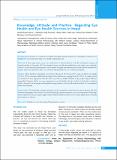Please use this identifier to cite or link to this item:
https://hdl.handle.net/20.500.14356/1387Full metadata record
| DC Field | Value | Language |
|---|---|---|
| dc.contributor.author | Mishra, Sailesh Kumar | - |
| dc.contributor.author | Chowhan, Sudhinder Singh | - |
| dc.contributor.author | Shah, Ranjan | - |
| dc.contributor.author | Jha, Nisha | - |
| dc.contributor.author | Shankar, Pathiyil Ravi | - |
| dc.contributor.author | Bhandary, Shital | - |
| dc.contributor.author | Gorkhaly, Anil Prasad | - |
| dc.date.accessioned | 2023-05-09T10:14:09Z | - |
| dc.date.available | 2023-05-09T10:14:09Z | - |
| dc.date.issued | 2019 | - |
| dc.identifier.citation | MishraS. K., ChowhanS. S., ShahR., JhaN., ShankarP. R., BhandaryS., & GorkhalyA. P. (2019). Knowledge, Attitude and Practice Regarding Eye Health and Eye Health Services in Nepal. Journal of Nepal Health Research Council, 17(2), 209-214. https://doi.org/10.33314/jnhrc.v0i0.1941 | en_US |
| dc.identifier.issn | Print ISSN: 1727-5482; Online ISSN: 1999-6217 | - |
| dc.identifier.uri | http://103.69.126.140:8080/handle/20.500.14356/1387 | - |
| dc.description | Original Article | en_US |
| dc.description.abstract | Abstract Background: This study was conducted to identify knowledge, attitude and practice of the public in relation to eye health and to assess their knowledge of eye health seeking behaviour. Methods: A three-stage cluster survey was conducted in 15 selected districts of the five development regions of Nepal from May to December 2017.One hundred clusters and fifty households from each cluster were randomly selected. A semi-structured questionnaire was developed in English and translated into Nepali and back translated by experts. Data were entered in CSPro 5.0.3 software and imported to R 3.4.1 software for analysis. Results: Three fourth of respondents were between the age of 20-59 years (84 %) and one third were female (37.4%). 78% of respondents had basic knowledge about ocular diseases (ranging from 68 to 95%). No single method was found to be more appropriate than the other to provide eye health education to the people living in different geographical locations. Radio was more appropriate to provide health education in Doti and television in Saptari district. Around 2% of the people still depended on drug retailers, 0.6% on self-medication and 0.1% on traditional healers for treatment. Conclusions: The knowledge, attitude and practice of the respondents varied between various districts and with different demographic characteristics. The overall knowledge, attitude and practice score and respondent’s knowledge about common eye diseases requires improvement. Different methods can be used to educate public about eye health and common eye diseases. Keywords: Attitude; eye care; knowledge; Nepal; practice; services | en_US |
| dc.language.iso | en | en_US |
| dc.publisher | Nepal Health Research Council | en_US |
| dc.relation.ispartofseries | Apr-June, 2019;1941 | - |
| dc.subject | Attitude | en_US |
| dc.subject | Eye care | en_US |
| dc.subject | Knowledge | en_US |
| dc.subject | Nepal | en_US |
| dc.subject | Practice | en_US |
| dc.subject | Services | en_US |
| dc.title | Knowledge, Attitude and Practice Regarding Eye Health and Eye Health Services in Nepal | en_US |
| dc.type | Journal Article | en_US |
| local.journal.category | Original Article | - |
| Appears in Collections: | Vol. 17 No. 2 Issue 43 Apr - Jun 2019 | |
Files in This Item:
| File | Description | Size | Format | |
|---|---|---|---|---|
| 1941-Manuscript-10747-1-10-20190804.pdf | Fulltext Download | 249.21 kB | Adobe PDF |  View/Open |
Items in DSpace are protected by copyright, with all rights reserved, unless otherwise indicated.
